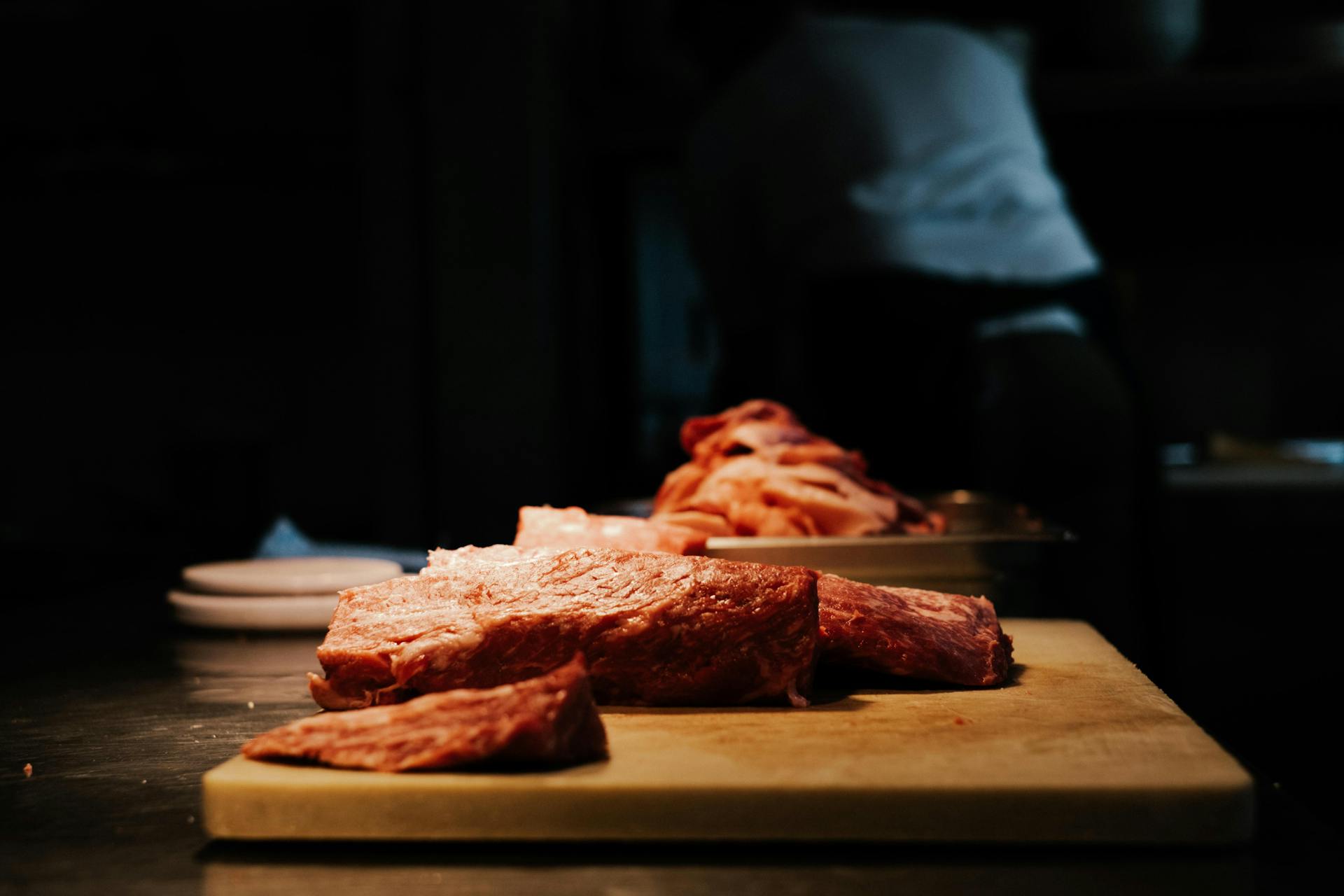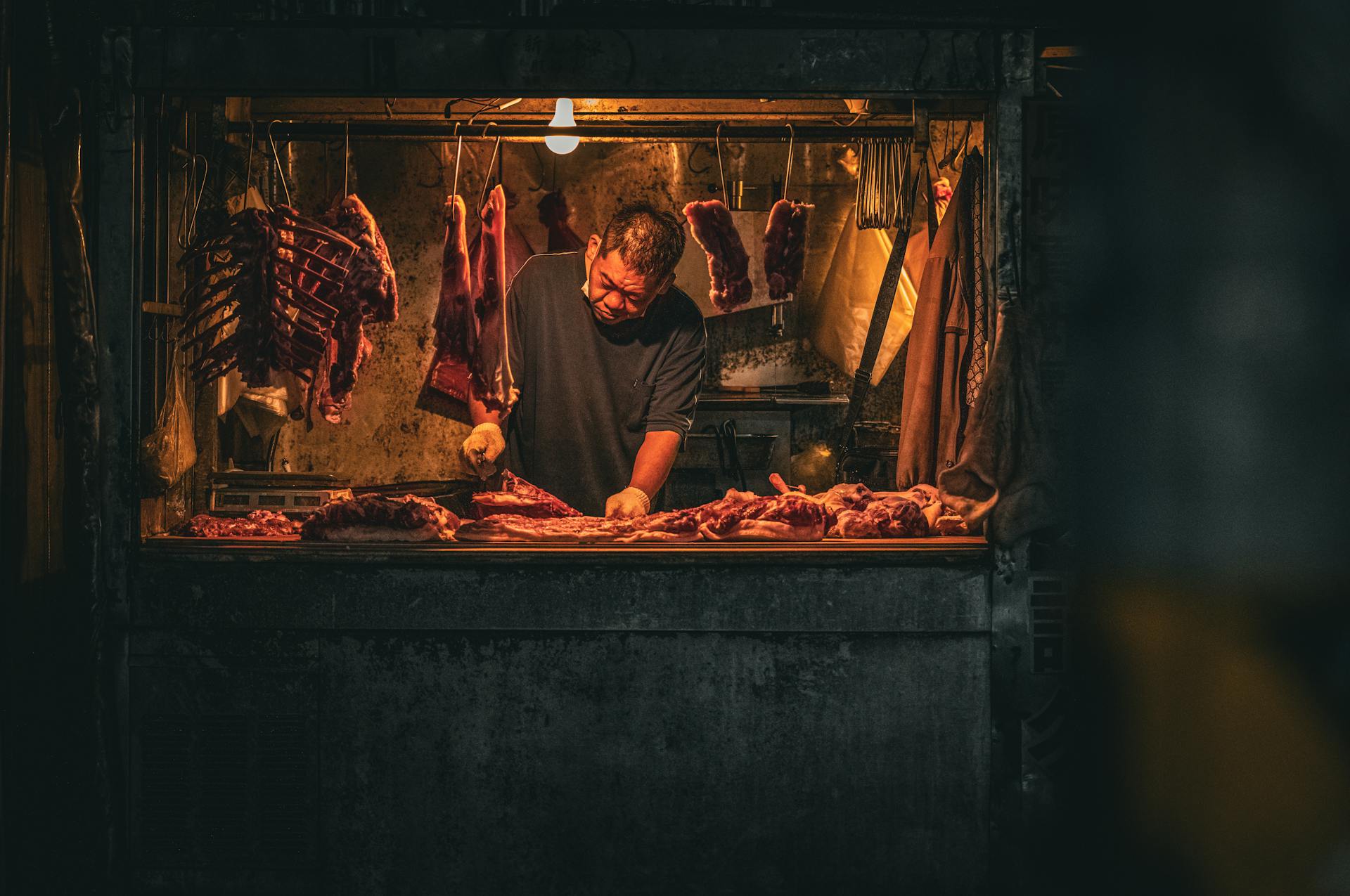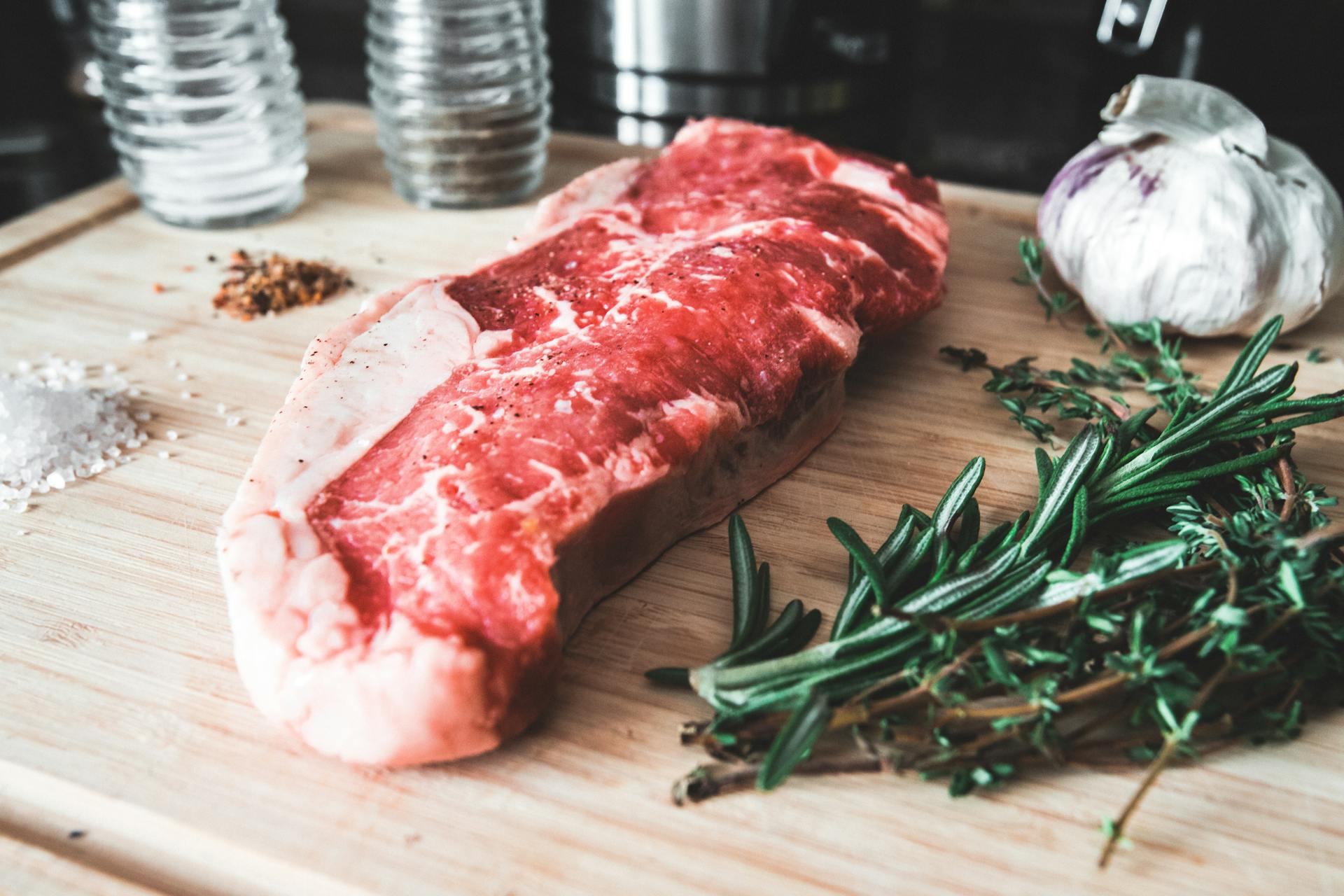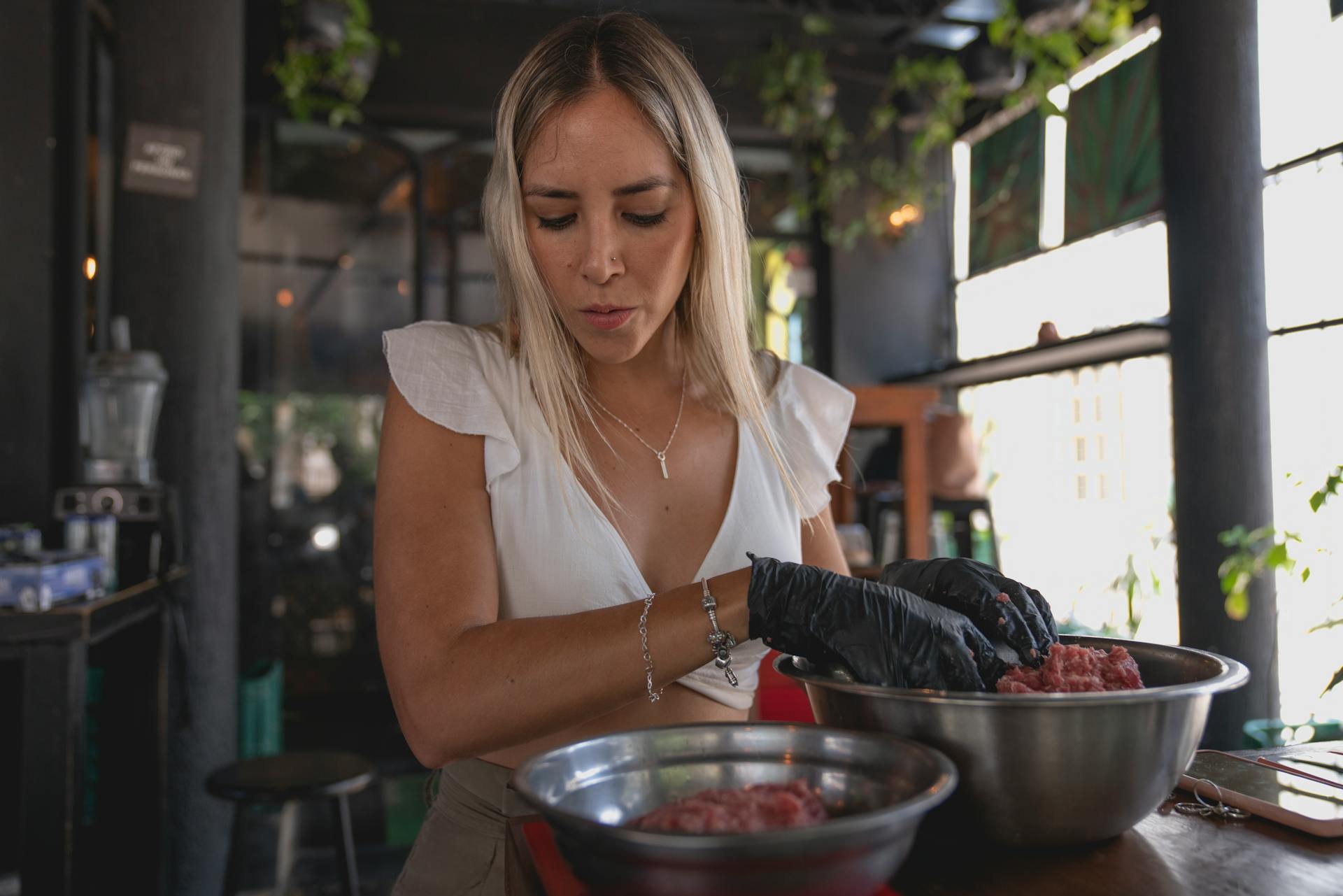
Organ meat is a nutritious addition to your dog's diet, providing essential vitamins and minerals.
Freshness is key when selecting organ meat for your dog.
Choose organ meats that are rich in iron, such as liver and kidney.
You can purchase organ meats from a butcher or a pet store.
Always store organ meats in the refrigerator or freezer to maintain freshness.
Types of Organ Meat
Organ meat is a nutrient-rich food source for dogs that can be sourced from various animals, such as beef, pork, and lamb.
Some common types of organ meat include liver, kidneys, and heart.
Each of these organ meats has its own unique nutritional profile, with liver being a rich source of iron and kidneys providing a boost of protein.
Liver is particularly beneficial for dogs due to its high concentration of vitamin A, which supports healthy vision and immune function.
Kidneys, on the other hand, are a good source of omega-3 fatty acids, which promote skin and coat health.
While heart is a lean protein source that can help support cardiovascular health in dogs.
What Is Meat?
Meat is the flesh of animals, typically obtained from the muscles of larger farm animals like cattle or sheep. Organ meat is a type of meat that comes from the internal organs of these animals.
Organ meat includes entrails, which are the internal organs of farm animals like cattle or sheep. Gizzards, hearts, and livers of fowl like chicken, duck, or turkey are also considered suitable organs to be fed to dogs.
Meat from farm animals is commonly used as a source of protein for dogs. Organ meat is a nutrient-rich food that can provide essential vitamins and minerals for canine health.
Suggestion: Australian Cattle Dog Herding Dogs
Healthy Meats
Brain is an excellent source of Vitamin A, with 147 IU per serving.
Adding just a few organs to your dog's diet can give their nutrition a significant boost. For example, kidney is extremely rich in nutrients, with 1,397 IU of Vitamin A and 98.0 mcg of folate.
Liver is the clear winner when it comes to Vitamin A, with an astonishing 16,898 IU per serving. It's also rich in other essential vitamins and minerals, including Vitamin D, Vitamin E, and Selenium.
Here's a breakdown of the top 5 organs for various vitamins and minerals:
Pasture-raised animals, in particular, contain even higher levels of essential nutrients than their grain-fed counterparts, making them an excellent choice for those looking to provide their dogs with the best possible nutrition.
Benefits and Nutritional Value
Organ meats are a nutrient-dense food that can provide essential vitamins and minerals for your dog. They contain significantly more vitamins, minerals, and other valuable nutrients than lean muscle meat.
One of the main benefits of organ meats is their high concentration of B vitamins, including vitamins B1, B2, B6, and B12. These vitamins are essential for digestion, cardiac health, metabolism, skin and coat health, and brain function.
Beef hearts, in particular, are a rich source of B vitamins, collagen, omega-3 fatty acids, taurine, and iron. Taurine supports heart strength and blood flow, while collagen helps with joint mobility.
Organ meats are also a good source of fat-soluble vitamins, including vitamins A, D, E, and K. These vitamins are critical for vision, immune system health, bone health, and much more.
Some of the most nutrient-dense organs include the liver, kidney, and lung. These organs are high in amino acids, vitamins, and minerals, making them an excellent addition to your dog's diet.
Here is a comparison of the nutritional values of different beef organs:
Feeding and Consumption
Feeding beef heart to your dog should make up only 5-10% of their daily food intake to avoid digestive issues.
Clancy Giesbrecht recommends incorporating beef heart into a larger, complete meal to ensure your dog gets a balanced diet.
You can feed beef heart to your dog as a nutritional topper, training treat, or single ingredient inside a larger meal.
Daily Consumption

Dogs can eat beef heart every day if it's incorporated into a larger, complete meal.
Beef hearts help meet your dog's muscle meat minimum requirements for the day, along with other essential vitamins, minerals, and protein.
Organ meats should make up to 25% of a dog's diet, reflecting the 25% weight ratio of organs in larger farm animals.
However, no single organ should account for more than 5% to 10% of a dog's diet, so be mindful of portion sizes.
Feeding raw organ meats is best, as it ensures your dog gets all the temperature-sensitive nutrients stored within the organs.
You can grind up the organ meats in a food grinder and portion them into daily rations, storing them in the freezer for later use.
It's not necessary to give your dog organ meats every single day, but rather aim for some variation in the diet and ensure your dog gets sufficient amounts over the course of a week.
Feeding beef heart as 5-10% of your dog's daily food intake is a good starting point, but be aware that too much can cause diarrhea or an upset stomach due to its richness.
Check this out: Which of the following Organs Does a Dog Not Have?
Feeding Dogs Raw
Feeding dogs raw can be a game-changer for their health and well-being.
Raw organ meats are best fed raw, as this ensures your dog gets all the temperature-sensitive nutrients stored within the organs.
You can grind up the raw organ meats in a food grinder to make it easier to portion and store in the freezer.
Freezing is a great way to preserve the nutrients in raw organ meats.
Feeding your dog raw beef heart is a great option, as dogs are naturally designed to eat raw meat.
Raw beef heart is a nutrient-rich food that can be fed as a topper or mixed into a larger meal.
If you're new to feeding your dog raw beef heart, start with small amounts and gradually increase the amount to prevent digestive issues.
You can also try freeze-dried raw beef heart for a less messy option.
Always follow safe food handling techniques when feeding raw food to your dog.
Curious to learn more? Check out: What Is a Raw Meat Diet for Dogs
Feeding your dog raw beef heart can be a great way to add variety to their diet.
It's not necessary to feed your dog raw beef heart every day, but aim to include it in their diet a few times a week.
Be sure to introduce new foods slowly to prevent digestive upset, and consider adding a soothing agent like pumpkin or spinach puree to help calm their stomach.
Broaden your view: Raw Meat Make Dogs Aggressive
Preparing and Handling
Cooked beef liver is a safe and nutritious ingredient for your pup, making it a great addition to their meals.
For dogs on a non-raw diet, liver should be cooked before being incorporated into their meals. This ensures the nutrients are easily digestible for your dog.
Beef liver should be served once or twice a week as part of a balanced meal plan, making up no more than 10% of your dog's diet.
Here's an interesting read: What Food Makes Dogs Sick
Spleen
Spleen is a nutrient-rich organ that's often overlooked, but it's a great addition to a raw diet for developing puppies due to its high iron content.
The iron in spleen is particularly high, making it a beneficial organ to include in raw diets.
To give you an idea of spleen's nutritional profile, here are the top nutrients found in 1 oz (28g) of raw beef spleen:
Spleen is not as commonly sourced as liver and kidney organs, but you can often find it at ethnic markets or specialty butchers.
Pancreas
The pancreas organ is a valuable addition to raw diets, especially for pets with sensitive digestive systems. It provides digestive enzymes that can aid in the breakdown of nutrients.
Raw pancreas is rich in essential nutrients, making it a nutritious supplement for pets. In fact, a 1oz serving of raw beef pancreas contains 3.97 mcg of vitamin B12, a crucial nutrient for energy production and nerve function.
Here are the top nutrients found in raw beef pancreas, per 1oz serving:
The pancreas organ is not just a source of vitamins and minerals, but also provides a boost to the digestive system.
Heart

A beef heart can weigh up to 10 pounds and is made of dense muscle meat surrounded by a layer of fat.
Beef hearts are sold raw or freeze-dried and can be purchased from online pet retailers, local natural pet stores, butchers, or raw co-ops. Ideally, source human-grade meats from grass-fed animals.
You can't give your dog a meal of 100% beef heart, but you can incorporate it into their overall diet as a nutritional topper, training treat, or single ingredient inside a larger meal.
To feed beef hearts to your dog, you can either feed freeze-dried hearts immediately or crumble them up first. Raw hearts should be thawed in the refrigerator for about 24 hours before serving.
If your pup hasn't eaten beef heart before, introduce it slowly to see how they do, and monitor quantities to avoid diarrhea. Consider adding a soothing agent like pumpkin or spinach puree to their meal.
See what others are reading: Feeding Dogs Raw Hamburger Meat

Beef hearts are a rich source of B vitamins, collagen, omega-3 fatty acids, taurine, and iron. They support heart strength and blood flow, promote shiny skin and coats, and reduce inflammation and allergenic symptoms.
Here's a quick rundown of the benefits of beef hearts for your dog:
- Rich in B vitamins, collagen, omega-3 fatty acids, taurine, and iron
- Supports heart strength and blood flow
- Promotes shiny skin and coats
- Reduces inflammation and allergenic symptoms
You can feed your dog raw beef heart as part of a balanced diet, as they are carnivorous canines well-adapted to eat raw meat.
Food Safety
When preparing treats for your dog, make sure to cook beef liver before serving it to them. Beef liver is a good source of vitamin A and B, iron, and other vitamins and minerals.
Beef liver should only make up 10% of your dog's diet, so it's best to serve it as an occasional treat. Treats like beef liver should be served once or twice a week as part of a balanced meal plan.
Recipes
When preparing recipes for your dog, it's essential to use simple ingredients that are safe for them to eat.

Beef liver is a great ingredient to use in recipes, but you'll need to adjust the quantity based on your dog's size and activity level. Consult with your veterinarian or a canine nutritionist for personalized advice.
If you can't get to a vet, online services like PangoVet offer affordable and convenient consultations.
To make baked liver treats, try using beef liver as an ingredient.
Food Topper
Adding a food topper to your pet's regular meal can be a great way to give them an extra nutrition boost. This is especially helpful if your pup isn't a fan of eating plain liver.
You can make a liver food topper by blending 1 pound of beef liver in a food processor until it reaches a paste-like consistency.
Adding this blended liver to your pet's regular meal can give them a boost of flavor and nutrition.
Where to Buy and Alternatives
For best results, source raw hearts from an online pet retailer, a local natural pet store, a trusted butcher, or a raw co-op. Ideally, try to find human-grade meats from grass-fed animals.
You can also purchase beef hearts freeze-dried, which is a convenient option. However, raw hearts are the preferred choice for canines.
Where to Buy Hearts

If you're looking to purchase beef hearts for your furry friends, you can find them raw or freeze-dried. They can be bought as a single ingredient or as part of a blend.
For the best results, source raw hearts from an online pet retailer, a local natural pet store, or a trusted butcher. You can also try a raw co-op. Ideally, find human-grade meats from grass-fed animals.
You can also shop online and have them delivered to your doorstep. Oma's Pride is a great option, offering high-quality beef hearts made exclusively in the United States.
A whole beef heart can weigh up to around 10 pounds, so make sure you have enough storage space. The raw beef heart is made up of very dark red, dense muscle meat, partly surrounded by a layer of fat.
Here are some options to consider:
- Online pet retailers
- Local natural pet stores
- Trusted butchers
- Raw co-ops
- Oma's Pride
Comparing Chicken Alternatives
If you're looking for a chicken alternative, beef hearts are a great option. They contain less fat and more protein than chicken hearts.
Beef hearts are also higher in B vitamins, making them a nutritious choice for dogs.
If you're on a budget, chicken hearts are a cheaper option.
Frequently Asked Questions
Should dogs eat organ meat raw or cooked?
For optimal nutrient absorption, dogs should ideally eat organ meat raw, as many of its nutrients are temperature sensitive and can be destroyed by cooking. Cooking organ meat can reduce its nutritional value, making raw feeding a preferred option.
How to cook turkey organ meat for dogs?
To cook turkey organ meat for dogs, bring water to a boil and simmer the giblets for 20-30 minutes until no pink remains. Then, chop the cooked heart and liver into bite-sized pieces and serve as a nutritious topper for your dog's pet food.
Sources
- https://perfectlyrawsome.com/raw-feeding-knowledgebase/liver-other-secreting-organs/
- https://campfiretreats.com/blogs/campfire-tales/can-dogs-eat-organ-meats
- https://omaspride.com/blog/beef-hearts-for-dogs
- https://www.dogster.com/dog-nutrition/how-to-cook-beef-liver-for-dogs
- https://vetericyn.com/blog/organ-meat-for-dogs/
Featured Images: pexels.com


